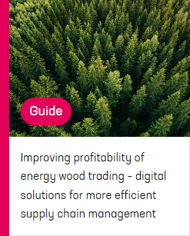Energy wood supply chains involve several parties working with the same raw material, but each from their own perspective. The chain starts from the forest owners and leads to various procurement organizations, buyers and end-users. In between, there is a wide range of forest service companies and contractors, from loggers to felling contractors and transport companies, and from sawmills to laboratories measuring the energy content of the timber. The vast majority of supply chain products end up in boilers in heating and power plants and for heating and fuel for residential buildings.
As the supply chain involves many steps and actors, there is a lot of variation in the methods and systems available. Energy wood trading also involves certain accounting requirements that put pressure and time-consuming cycles on the different steps, data generation and reporting.
Indeed, a typical situation for many operators is that the core business functions are running smoothly, but data management is a challenge. It is not always clear what species of energy trees the owner has at any given time, and where they are located.
In the guide, we answer e.g. the following questions:
- The key nodes in the energy wood supply chain and how to facilitate them?
- Pitfalls of Excel in the energy wood supply chain management
- Information systems for the energy wood industry – to whom, why, how?
- Case study: Metsäenergia Meter Oy

Download the guide by filling out the form. The guide is free of charge and downloading does not bind you to anything.
Here are some contents that might also interest you:
- Guide: Improve the strategic planning of the forest business
- Webinar recording: Deforestation Regulation (EUDR) and Sustainability Reporting Directive (CSRD)
- Blog: The EU Deforestation Regulation (EUDR) and the wood industry – what is required of operators in practice?
- Guide: How to respond to the requirements of the EUDR Deforestation Regulation in the wood industry?
- Blog: Energy wood is now at record levels of competition – a software partner helps wood sourcing organizations monitor profitability of energy wood trade
- Success story: Metsäenergia
- Pinja's software for the forest industry